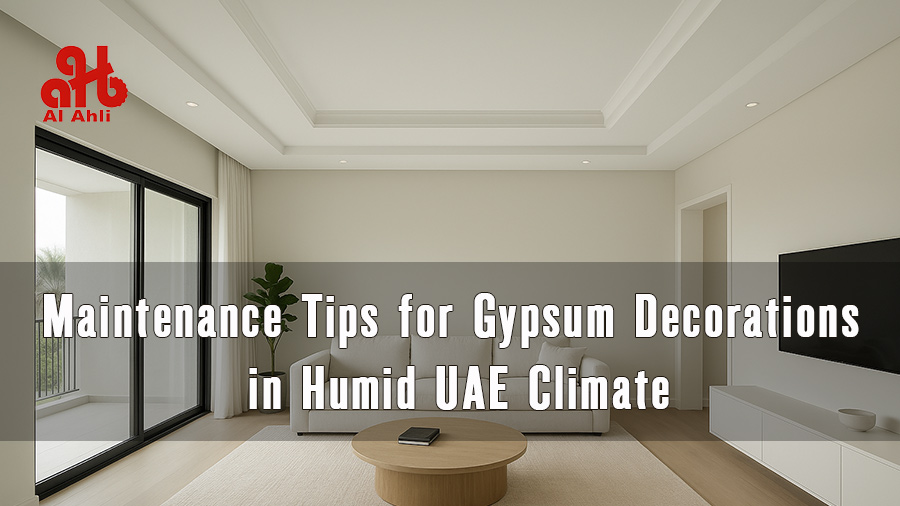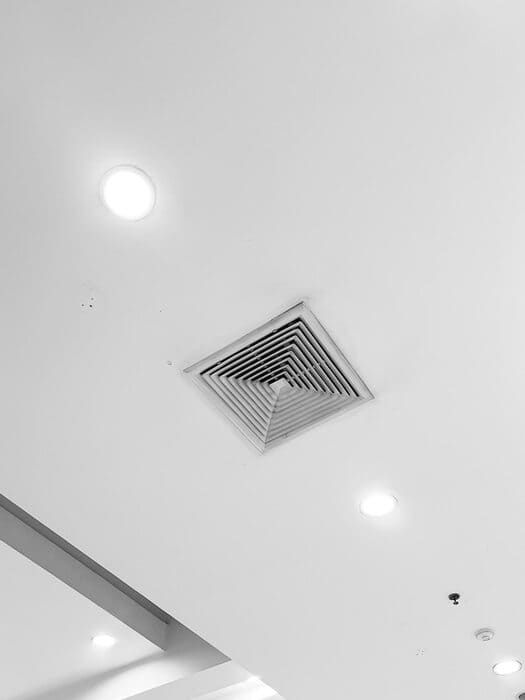Gypsum Decoration in Humid Climate
Gypsum is one of the most popular materials in interior design across the UAE — loved for its smooth texture, elegant appearance, and versatility. From decorative ceilings to wall panels and cornices, gypsum adds sophistication to homes, offices, and hotels. However, the humid climate of the UAE, especially in coastal cities like Dubai, Sharjah, and Abu Dhabi, can pose challenges for maintaining gypsum decorations. Moisture, heat, and poor ventilation can all affect the look and longevity of gypsum structures. Fortunately, with the right care and maintenance, you can keep your gypsum décor looking brand new for years.

Understand How Humidity Affects Gypsum decoration
Before diving into maintenance, it’s essential to understand why gypsum needs special care in humid environments. Gypsum is a porous material — it naturally absorbs moisture from the air. In the UAE’s coastal areas, where humidity levels can reach 80% or higher, this can lead to swelling, discoloration, or even minor cracking. Recognizing these risks helps homeowners and interior designers take preventive steps early on.
Use Proper Surface Sealing and Paint
The first line of defense against humidity is sealing and painting. After installation, gypsum surfaces should be coated with a high-quality primer and moisture-resistant paint. These coatings act as a protective layer, preventing damp air from penetrating the gypsum. In areas like bathrooms, kitchens, or coastal properties, you can go a step further by applying a waterproof sealant. This small investment dramatically extends the lifespan of your gypsum décor and keeps it looking crisp and clean.

Maintain Proper Ventilation
One of the simplest yet most effective maintenance tips is to ensure good airflow. Humidity tends to accumulate in closed spaces, so keeping air circulating helps prevent moisture buildup. Installing exhaust fans in bathrooms and kitchens or using dehumidifiers in enclosed areas can make a big difference. For villas and apartments with false gypsum ceilings, it’s smart to include ventilation grilles or small vents to allow air movement between ceiling layers.
Regular Cleaning with the Right Techniques
Gypsum surfaces should be cleaned gently and regularly. Dust and humidity can combine to form thin layers of grime, which dull the surface over time. Use a soft, dry microfiber cloth to wipe surfaces weekly. Avoid wet cloths or cleaning sprays, as water can seep into cracks and damage the structure. If stains appear, lightly dampen the cloth and dry the surface immediately after cleaning.
Monitor for Early Signs of Damage
Humidity-related damage starts subtly — small cracks, tiny bubbles under paint, or slight discoloration. Inspect your gypsum ceilings and moldings every few months to catch issues early. If you notice soft spots or warping, it might indicate water exposure behind the gypsum. In such cases, call a professional before the damage spreads. Early detection prevents expensive repairs later on.
Control Indoor Humidity Levels
In the UAE’s climate, indoor humidity control is crucial. Air conditioning helps reduce moisture, but it’s not always enough. Invest in a dehumidifier to maintain humidity between 40% and 55%. Smart home systems can even monitor humidity automatically and adjust air conditioning accordingly. Keeping indoor humidity stable not only protects gypsum but also enhances comfort and prevents mold growth.
Choose High-Quality Materials from the Start
Not all gypsum products are equal. For humid regions, it’s best to use moisture-resistant gypsum boards or plaster formulations specifically designed for tropical climates. These are more durable, less porous, and better suited for long-term use in UAE conditions. Many suppliers in Dubai and Sharjah now offer gypsum products labeled “water-resistant” or “for wet areas” — an ideal choice for bathrooms, kitchens, and coastal properties.
Avoid Direct Water Contact
While gypsum can handle ambient humidity, direct contact with water is a major threat. Always make sure there are no leaking pipes, dripping AC units, or roof seepage above gypsum ceilings. If any water damage occurs, dry the area immediately and call an expert to assess whether the gypsum needs replacement. Even minor water exposure can compromise structural integrity over time.
Professional Maintenance Once a Year
For large villas, hotels, or commercial spaces with extensive gypsum décor, scheduling annual maintenance is wise. Professionals can check for hidden moisture pockets, repaint or reseal surfaces if necessary, and ensure all lighting fixtures integrated into gypsum ceilings are functioning safely. A yearly checkup keeps your interiors fresh and prevents major problems before they start.
Conclusion
Maintaining gypsum decorations in the UAE’s humid climate may sound challenging, but with proper care, they can remain stunning for years. The key is prevention, ventilation, and timely maintenance. Whether it’s your home, office, or restaurant, protecting your gypsum ceilings and walls ensures they continue to reflect elegance, quality, and craftsmanship — even in the face of the UAE’s harsh weather conditions.

